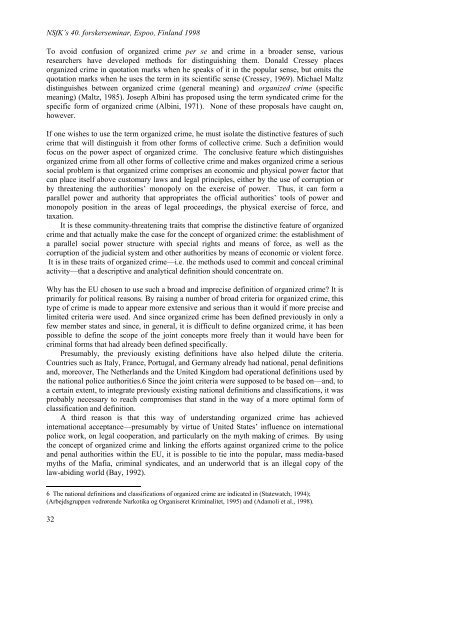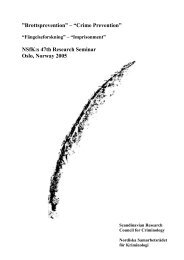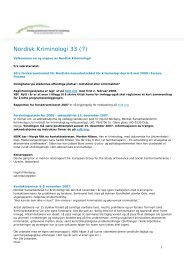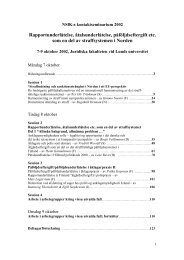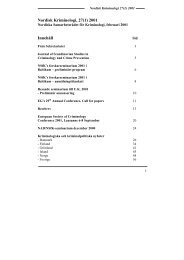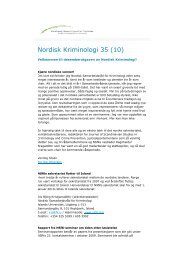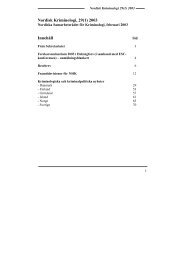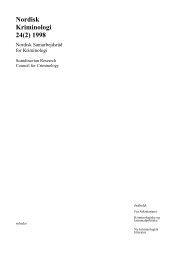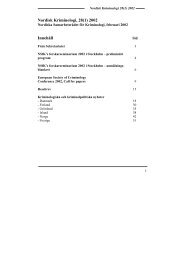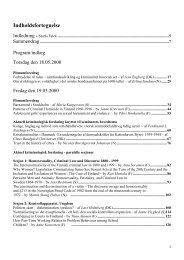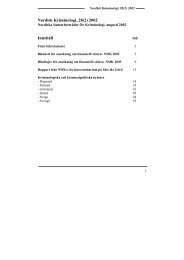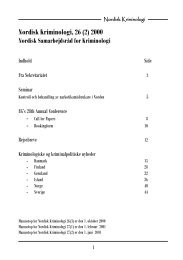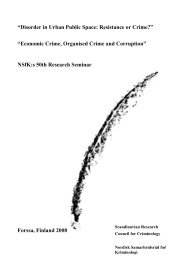Organised Crime & Crime Prevention - what works? - Scandinavian ...
Organised Crime & Crime Prevention - what works? - Scandinavian ...
Organised Crime & Crime Prevention - what works? - Scandinavian ...
Create successful ePaper yourself
Turn your PDF publications into a flip-book with our unique Google optimized e-Paper software.
NSfK’s 40. forskerseminar, Espoo, Finland 1998<br />
To avoid confusion of organized crime per se and crime in a broader sense, various<br />
researchers have developed methods for distinguishing them. Donald Cressey places<br />
organized crime in quotation marks when he speaks of it in the popular sense, but omits the<br />
quotation marks when he uses the term in its scientific sense (Cressey, 1969). Michael Maltz<br />
distinguishes between organized crime (general meaning) and organized crime (specific<br />
meaning) (Maltz, 1985). Joseph Albini has proposed using the term syndicated crime for the<br />
specific form of organized crime (Albini, 1971). None of these proposals have caught on,<br />
however.<br />
If one wishes to use the term organized crime, he must isolate the distinctive features of such<br />
crime that will distinguish it from other forms of collective crime. Such a definition would<br />
focus on the power aspect of organized crime. The conclusive feature which distinguishes<br />
organized crime from all other forms of collective crime and makes organized crime a serious<br />
social problem is that organized crime comprises an economic and physical power factor that<br />
can place itself above customary laws and legal principles, either by the use of corruption or<br />
by threatening the authorities’ monopoly on the exercise of power. Thus, it can form a<br />
parallel power and authority that appropriates the official authorities’ tools of power and<br />
monopoly position in the areas of legal proceedings, the physical exercise of force, and<br />
taxation.<br />
It is these community-threatening traits that comprise the distinctive feature of organized<br />
crime and that actually make the case for the concept of organized crime: the establishment of<br />
a parallel social power structure with special rights and means of force, as well as the<br />
corruption of the judicial system and other authorities by means of economic or violent force.<br />
It is in these traits of organized crime—i.e. the methods used to commit and conceal criminal<br />
activity—that a descriptive and analytical definition should concentrate on.<br />
Why has the EU chosen to use such a broad and imprecise definition of organized crime? It is<br />
primarily for political reasons. By raising a number of broad criteria for organized crime, this<br />
type of crime is made to appear more extensive and serious than it would if more precise and<br />
limited criteria were used. And since organized crime has been defined previously in only a<br />
few member states and since, in general, it is difficult to define organized crime, it has been<br />
possible to define the scope of the joint concepts more freely than it would have been for<br />
criminal forms that had already been defined specifically.<br />
Presumably, the previously existing definitions have also helped dilute the criteria.<br />
Countries such as Italy, France, Portugal, and Germany already had national, penal definitions<br />
and, moreover, The Netherlands and the United Kingdom had operational definitions used by<br />
the national police authorities.6 Since the joint criteria were supposed to be based on—and, to<br />
a certain extent, to integrate previously existing national definitions and classifications, it was<br />
probably necessary to reach compromises that stand in the way of a more optimal form of<br />
classification and definition.<br />
A third reason is that this way of understanding organized crime has achieved<br />
international acceptance—presumably by virtue of United States’ influence on international<br />
police work, on legal cooperation, and particularly on the myth making of crimes. By using<br />
the concept of organized crime and linking the efforts against organized crime to the police<br />
and penal authorities within the EU, it is possible to tie into the popular, mass media-based<br />
myths of the Mafia, criminal syndicates, and an underworld that is an illegal copy of the<br />
law-abiding world (Bay, 1992).<br />
6 The national definitions and classifications of organized crime are indicated in (Statewatch, 1994);<br />
(Arbejdsgruppen vedrørende Narkotika og Organiseret Kriminalitet, 1995) and (Adamoli et al., 1998).<br />
32


